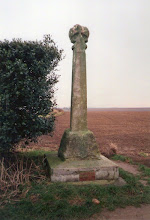This year I'm repeating the ECW early war campaign I tested last year with the aim of fighting the battled on the actual days. Tonight it was Powick Bridge.
This year I tinkered a little more with the terrain to ensure Colonel Sandys' cavalry regiment had to fight its way down the lane leading Wick Field under fire from Rupert's dragoons behind the hedgerows, while providing some opportunity for Wick Field to come into play a bit more.
 |
| Deployment: with the Parliamentary force in the foreground |
Rupert, deployed his dragoons in the wood along the lane, while his shot and main force of cavaliers remained in Wick Field. Parliament moved first and was obliged to move down the lane a full movement allowance in this turn.
 |
| Position about three turns into the game viewed from Royalist position. |
All through the game Rupert's force suffered command issues (no Pips!) giving Parliament the initiative. This allowed Sandys' Regiment to charge down the lane while their dragoons cleared the woods - destroying Rupert's dragoons in the process.
A melee raged back and forth at the entrance to Wick Field but neither side could gain advantage.
 |
| Final dispositions on 12th October 1642 |
The break down in command among the Royalist forces (due to a lack of pips) resulted in teh second loss with Rupert's commanded shot getting caught out in the field on their left - having incautiously ventured out from the safety of the hedgerows - and was ridden down by cavalry and shot on Parliament's right. Rupert, sensing the day was lost, withdrew to Worcester to count the cost.
The Royalists lost one unit of shot and one of dragoons - Parliament had no losses. Replacements were rolled for by the Royalists (4, 5 or 6 on a D6 meaning a unit was replaced before the next battle) with the shot unable to be replaced but the dragoons were successfully reinforced. This will leave the king with only 11 elements at the next battle.
On to Edgehill!

















































